- Table of Contents
- Related Documents
-
| Title | Size | Download |
|---|---|---|
| 01-Text | 2.46 MB |
Contents
General safety recommendations
Examining the installation site
Installation tools and accessories
Mounting the router on a workbench
Connecting the console cable and setting terminal parameters
Replacing a transceiver module
No display on the configuration terminal
Garbled display on the configuration terminal
No response from the serial console port
Restoring the factory settings
Appendix A Chassis views and technical specifications
Preparing for installation
Table 1 This document applies to the following device models:
|
Model |
Product code |
|
MSR2600-6-X1-GL |
RT-MSR2600-6-X1-GL |
Safety recommendations
Safety symbols
When reading this document, note the following symbols:
![]() WARNING means an alert that calls attention to important
information that if not understood or followed can result in personal injury.
WARNING means an alert that calls attention to important
information that if not understood or followed can result in personal injury.
![]() CAUTION means an alert that calls attention to important
information that if not understood or followed can result in data loss, data
corruption, or damage to hardware or software.
CAUTION means an alert that calls attention to important
information that if not understood or followed can result in data loss, data
corruption, or damage to hardware or software.
General safety recommendations
· Keep the router and installation tools away from walk areas.
· Place the router in a dry and flat location and make sure anti-slip measures are in place.
· Remove all external interface cables and power cords before moving the router.
Electricity safety
· Locate the power-off switch in the equipment room before installation. Shut off the power immediately if an accident occurs. Disconnect the power cord from the router if necessary.
· Make sure the router is reliably grounded.
· Connect the interface cables correctly.
· Use an uninterrupted power supply (UPS).
· Always make sure the power has been disconnected during the installation or replacement procedure.
Examining the installation site
The router can only be used indoors. To ensure correct operation and a long lifespan for your router, install it in an environment that meets the requirements described in the following subsections.
Temperature and humidity
Maintain the temperature and humidity in the equipment room as described in Table 2.
· Lasting high relative humidity can cause poor insulation, electricity leakage, mechanical property change of materials, and metal corrosion.
· Lasting low relative humidity can cause washer contraction and ESD and cause problems including loose mounting screws and circuit failure.
· High temperature can accelerate the aging of insulation materials and significantly lower the reliability and lifespan of the router.
Table 2 Temperature and humidity requirements
|
Temperature |
Humidity |
|
Operating temperature: 0°C to 45°C (32°F to 113°F) Storage temperature: –40°C to +70°C (–40°F to +158°F) |
5% RH to 95% RH, noncondensing |
Cleanliness
Dust buildup on the chassis might result in electrostatic adsorption, which causes poor contact of metal components and contact points, especially when indoor relative humidity is low. In the worst case, electrostatic adsorption can cause communication failure.
Table 3 Dust concentration limit in the equipment room
|
Substance |
Concentration limit (particles/m3) |
|
Dust particles |
≤ 3 x 104 (No visible dust on the tabletop in three days) |
|
NOTE: Dust diameter ≥ 5 µm |
|
The equipment room must also meet limits on salts, acids, and sulfides to eliminate corrosion and premature aging of components, as shown in Table 4.
Table 4 Harmful gas limits in an equipment room
|
Gas |
Maximum concentration (mg/m3) |
|
SO2 |
0.2 |
|
H2S |
0.006 |
|
NH3 |
0.05 |
|
NO2 |
0.04 |
|
Cl2 |
0.01 |
Cooling system
The router uses left-to-right airflow for heat dissipation, as shown in Figure 1.
Figure 1 Airflow through the chassis
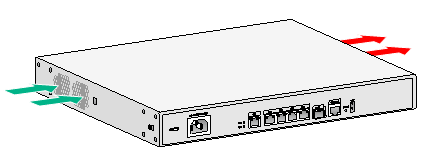
To ensure good ventilation, follow these guidelines:
· Maintain a minimum clearance of 10 cm (3.94 in) around the air inlet and outlet vents.
· Make sure the installation site has a good ventilation system.
ESD prevention
Preventing electrostatic discharge
To prevent electrostatic discharge (ESD), follow these guidelines:
· Make sure the router and the floor are reliably grounded.
· Take dust-proof measures for the equipment room.
· Maintain the humidity and temperature levels in the acceptable range.
· Always wear an ESD wrist strap and an ESD garment when touching a circuit board or transceiver module.
· Place the removed interface module on an antistatic workbench with the circuit board upward, or put it in an antistatic bag.
· Touch only the edges instead of electronic components on the circuit board when you observe or move a removed interface module.
Attaching an ESD wrist strap
|
|
CAUTION: Use a multimeter to check the resistance of the ESD wrist strap for safety. The resistance reading should be in the range of 1 to 10 megohm (Mohm) between a human body and the ground. |
No ESD wrist strap is provided with the router. Prepare one yourself.
To attach an ESD wrist strap:
1. Wear the wrist strap on your wrist.
2. Lock the wrist strap tight around your wrist to maintain good contact with the skin.
3. Secure the wrist strap lock and the alligator clip lock together.
4. Attach the alligator clip to the grounding screw on the router.
EMI prevention
All electromagnetic interference (EMI) sources, from outside or inside of the router and application system, adversely affect the router in the following ways:
· A conduction pattern of capacitance coupling.
· Inductance coupling.
· Electromagnetic wave radiation.
· Common impedance (including the grounding system) coupling.
To prevent EMI, use the following guidelines:
· If AC power is used, use a single-phase three-wire power receptacle with protection earth (PE) to filter interference from the power grid.
· Keep the router far away from radio transmitting stations, radar stations, and high-frequency devices.
· Use electromagnetic shielding, for example, shielded interface cables, when necessary.
· To prevent signal ports from getting damaged by overvoltage or overcurrent caused by lightning strikes, route interface cables only indoors.
Lightning protection
To enhance lightning protection for the router, follow these guidelines:
· Make sure the router is reliably grounded.
· Make sure the AC power outlet is reliably grounded.
· Install a lightning protector at the power input end.
· Install a lightning protector at the input end of signal cables routed from outdoors, for example, E1/T1 cable.
Rack requirements
To install the router in a rack, make sure the rack meets the following requirements:
· The rack has a good ventilation system.
· The rack is sturdy and can support the router and its accessories.
· The rack has a size that can accommodate the router.
· Enough clearances are reserved at the two sides of the router for heat dissipation.
· A minimum of 0.8 m (2.62 ft) of clearance is reserved between the rack and walls or other devices for heat dissipation and maintenance.
· The headroom in the equipment room is not less than 3 m (9.84 ft).
Installation tools and accessories
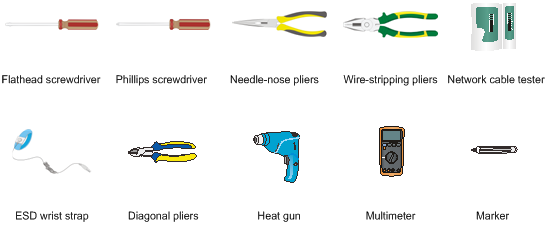
Figure 3 Installation accessories
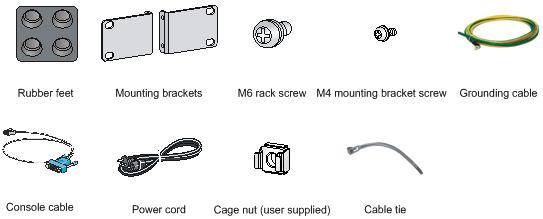
Pre-installation checklist
|
Item |
Requirements |
|
|
Installation site |
Ventilation |
· A minimum clearance of 100 mm (3.94 in) is reserved around the air inlet and outlet vents. · The installation site has a good ventilation system. |
|
Temperature |
Operating temperature: 0°C to 45°C (32°F to 113°F) Storage temperature: –40°C to +70°C (–40°F to +158°F) |
|
|
Humidity |
5% RH to 95% RH (noncondensing) |
|
|
Cleanliness |
Dust concentration ≤ 3 × 104 particles/m3 (no visible dust on the tabletop over three days) |
|
|
ESD prevention |
· The router and floor are reliably grounded. · Dust-proof measures are taken in the equipment room. · Humidity and temperature are maintained at acceptable levels. · An ESD wrist strap and ESD garment are available. · An anti-static workbench and anti-static bags are available. |
|
|
EMI prevention |
· A single-phase three-wire power receptacle with protection earth (PE) is available for filtering interference from the power grid. · The router is far away from radio transmitting stations, radar stations, and high-frequency devices. · Electromagnetic shielding, for example, shielded interface cables, is used as required. |
|
|
Lightning protection |
· The router is reliably grounded. · The AC power receptacle is reliably grounded. · (Optional.) Port lightning protectors are available. · (Optional.) Power lightning protectors are available. · (Optional.) Signal cable lightning protectors are available. |
|
|
Electricity safety |
· A UPS is available. · The power-off switch in the equipment room is identified and accessible so that the power can be immediately shut off when an accident occurs. |
|
|
Workbench |
· The workbench is stable. · The workbench is reliably grounded. |
|
|
Rack |
· The rack has a good ventilation system. · The rack is sturdy and can support the router and its accessories. · The rack has a size that can accommodate the router. · A minimum of 0.8 m (2.62 ft) of clearance is reserved between the rack and walls or other devices. |
|
|
Safety precautions |
The router is far away from any sources of heat or moisture. |
|
|
Installation tools and accessories |
· Installation accessories supplied with the router are ready. · User-supplied tools are ready. |
|
|
Reference |
· Documents shipped with the router are available. · Online documents are available. |
|
Installing the router
|
|
WARNING! To avoid injury, do not touch bare wires, terminals, or parts with high-voltage hazard signs. |
|
|
IMPORTANT: · The barcode on the router chassis contains product information that must be provided to local sales agent when you return a faulty router for repair. · Keep the tamper-proof seal on a mounting screw on the chassis cover intact, and if you want to open the chassis, contact H3C for permission. Otherwise, H3C shall not be liable for any consequence. |
Installation prerequisites
· You have read "Preparing for installation" carefully.
· All requirements in "Preparing for installation" are met.
Installation flowchart
You can install the router on a workbench or in a rack.
Determine the installation method according to the installation environment. Follow the installation flowchart shown in Figure 4 to install the router.
Figure 4 Installation flowchart
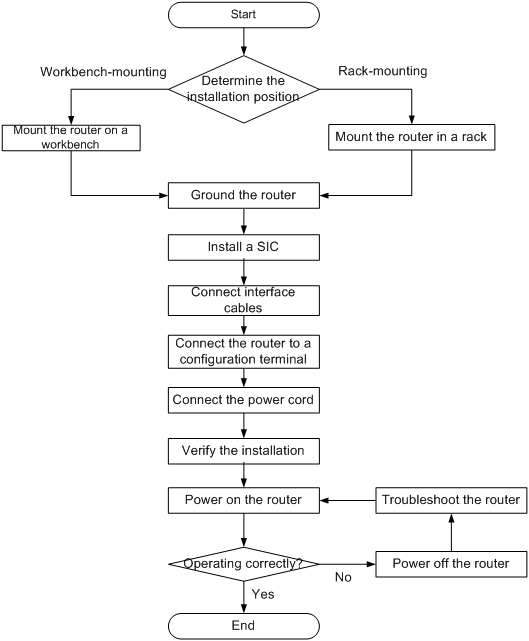
Installing the router
Mounting the router on a workbench
|
|
IMPORTANT: · Make sure the workbench is clean, stable, and reliably grounded. · Maintain a minimum clearance of 100 mm (3.94 in) around the router for heat dissipation. · Do not place heavy objects on the router. |
To mount the router on a workbench:
1. Place the router upside down on the workbench and attach the rubber feet to the four round holes in the chassis bottom.
2. Place the router upside up on the workbench. Make sure the rubber feet stand securely on the workbench.
Figure 5 Mounting the router on a workbench
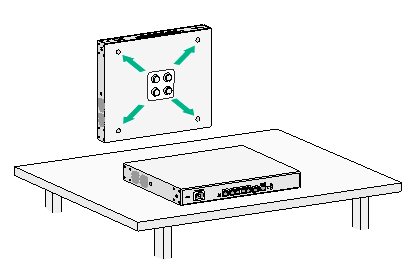
Mounting the router in a rack
Router dimensions and rack requirements
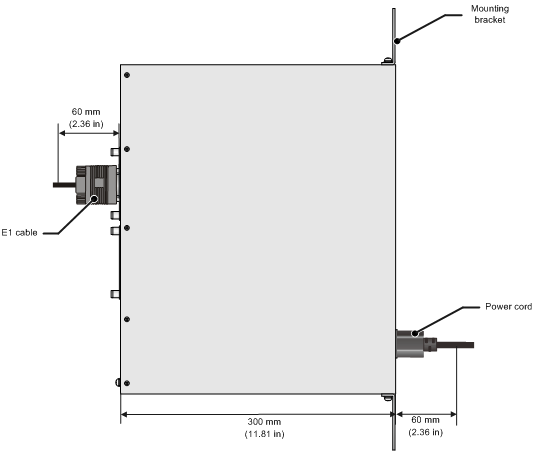
Table 5 Router dimensions and rack requirements
|
Chassis dimensions |
Rack requirements |
|
· Height—44.2 mm (1.74 in)/1 RU · Width—360 mm (14.17 in) · Depth—420 mm (16.54 in) ¡ 300 mm (11.81 in) for the chassis ¡ 60 mm (2.36 in) for connecting the AC power cord at the front ¡ 60 mm (2.36 in) for connecting the E1 cable at the rear |
· A minimum of 0.6 m (1.97 ft) in depth (recommended) · A minimum of 80 mm (3.15 in) between the front rack posts and the front door · A minimum of 360 mm (14.17 in) between the front rack posts and the rear door |
Installing the router in a rack
|
|
CAUTION: The mounting brackets can support only the weight of the router. Do not place objects on the router. |
To install the router in a rack:
1. Use a mounting bracket to mark the cage nut installation holes in the front rack posts, as shown in Figure 7.
Make sure the cage nut installation holes on the front rack posts are on a horizontal line.
Figure 7 Marking cage nut installation holes
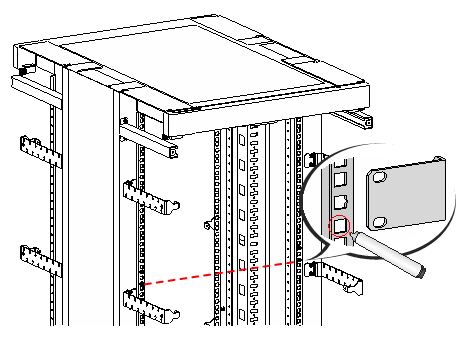
2. Install cage nuts, as shown in Figure 8.
a. Insert one ear of a cage nut into the marked installation hole.
b. Use a flathead screwdriver to push another ear into the same hole.
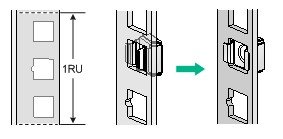
3. Attach mounting brackets to both sides of the router, as shown in Figure 9.
Figure 9 Attaching mounting brackets to the router
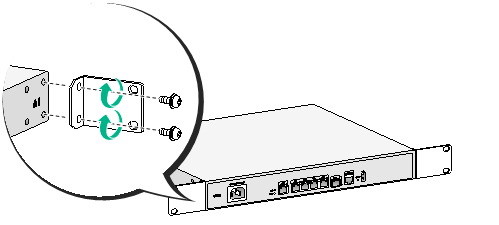
4. Use M6 screws to attach the mounting brackets on the router to the front rack posts, as shown in Figure 10.
Figure 10 Securing the router to the rack
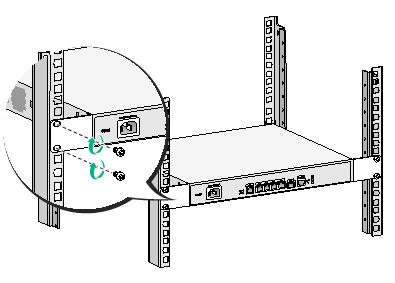
Grounding the router
|
|
CAUTION: · Correctly connecting the grounding cable is crucial to lightning protection and EMI protection. When you install and use the router, first ground the router reliably. · Ensure a minimum resistance of 5 ohms between the router and the ground. |
A grounding cable is provided with the router. You can use the grounding cable to ground the router.
To ground the router:
1. Remove the grounding screw from the grounding hole in the rear panel of the chassis.
2. Use the grounding screw to attach the ring terminal of the grounding cable to the grounding hole.
3. Use a Phillips screwdriver to fasten the grounding screw into the grounding screw hole.
4. Attach the other end of the grounding cable to the grounding strip.
Figure 11 Connecting the grounding cable to the router
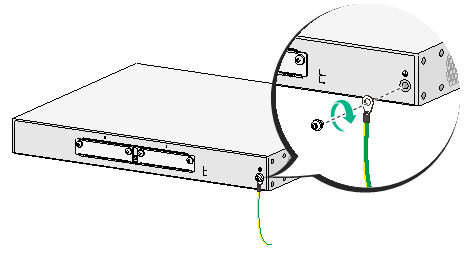
Installing a SIC
|
|
CAUTION: SIC interface modules are not hot swappable. Make sure the router is powered off before installing a SIC. |
To install a SIC:
1. Use a Phillips screwdriver to remove the fastening screws on the filler panel and remove the filler panel.
2. Push the SIC slowly into the slot along the guide rails until it makes close contact with the backplane of the router.
3. Fasten the captive screws on the SIC.
Figure 12 Installing a SIC
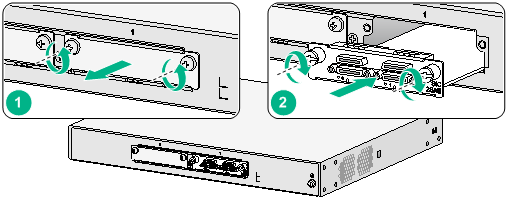
Connecting interface cables
Connect cables to the interfaces on the router before powering on the router.
The following procedure connects cables for Ethernet ports. For cable connection procedures for other types of ports, see the interface module manuals.
Connecting a copper Ethernet port
1. Connect one end of the cable to the target Ethernet port on the router and the other end to an Ethernet port on the peer device.
The fixed ports on the router are MDI/MDIX autosensing. You can use straight-through or crossover network cables to connect the ports.
2. Examine the port LED on the router to verify the connectivity. For more information about the LEDs, see "LED description."
Figure 13 Connecting a copper port to a computer

Connecting a fiber Ethernet port
|
|
WARNING! Disconnected optical fibers or transceiver modules might emit invisible laser light. Do not stare into beams or view directly with optical instruments when the router is operating. |
|
|
CAUTION: · To connect a fiber port by using an optical fiber, first install a transceiver module in the port and then connect the optical fiber to the transceiver module. · Insert a dust cap into any open optical fiber connector and a dust plug into any open fiber port or transceiver module port to protect them from contamination and ESD damage. · Never bend an optical fiber excessively. The bend radius of an optical fiber must be not less than 100 mm (3.94 in). · Keep the fiber end clean. · Make sure the Tx and Rx ports on a transceiver module are connected to the Rx and Tx ports on the peer end, respectively. |
To connect an optical fiber for a fiber port:
1. Pivot the bail latch of the transceiver module up so that it catches a knob on the top of the transceiver module.
2. Holding both sides of the transceiver module, insert the transceiver module slowly into the port.
3. Identify the Rx and Tx ports on the transceiver module. Use the optical fiber to connect the Rx port and Tx port on the transceiver module to the Tx port and Rx port on the peer end, respectively.
4. Examine the port LEDs:
¡ If the LED is on, a fiber link has been set up.
¡ If the LED is off, no link has been set up. The reason might be wrong connection of the Tx and Rx ends. Swap the fibers in the Tx and Rx ports at one end.
Figure 14 Connecting an optical fiber
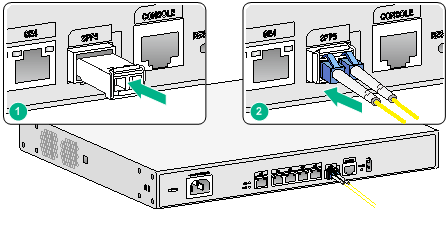
Connecting the console cable and setting terminal parameters
To access the router at the first time, you can only use a console cable to connect the console port on the router to a configuration terminal.
Connecting the console cable
|
|
CAUTION: The serial ports on PCs do not support hot swapping. To connect a PC to an operating router, first connect the PC end. To disconnect a PC from an operating router, first disconnect the router end. |
To connect the console cable:
1. Select a configuration terminal, which can be an ASCII terminal with an RS-232 serial port or a PC. (A PC is more commonly used.)
2. Connect the DB-9 connector (female) of the console cable to the RS-232 serial port on the configuration terminal and the RJ-45 connector to the console port of the router.
|
|
NOTE: If a PC does not have an RS-232 port but a USB port, use a USB to RS-232 adapter for the USB port and install the required driver. |
Figure 15 Connecting the console port to a configuration terminal
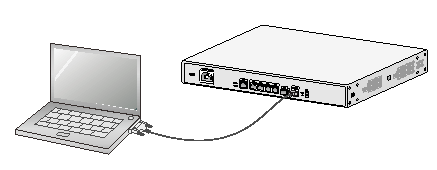
Setting configuration terminal parameters
To configure and manage the router through the console port, you must run a terminal emulator program, TeraTermPro or PuTTY, on your PC. You can use the emulator program to connect a network device, a Telnet site, or an SSH site. For more information about the terminal emulator programs, see the user guides for these programs.
The following are the required terminal settings:
· Baud rate—9600.
· Data bits—8.
· Stop bits—1.
· Parity—none.
· Flow control—none.
Connecting the AC power cord
1. Make sure the router is reliably grounded.
3. Connect the other end of the power cord to an AC power source.
The power cord in Figure 16 is for illustration only.
Figure 16 Connecting the AC power cord for the router
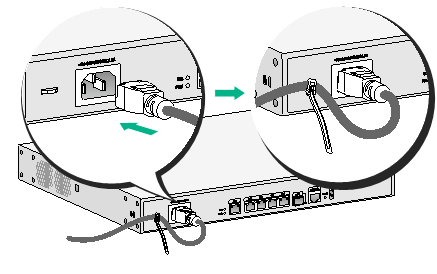
Verifying the installation
Verify the following items before you power on the router:
· There is enough space around the router for heat dissipation.
· The interface modules are installed correctly.
· The router, rack, and power source are reliably grounded.
· The power source is as required by the router.
· The router is connected correctly to the configuration terminal and other devices. The configuration terminal is configured correctly and has been started.
Starting the router
|
|
WARNING! Before powering on the router, locate the switch for the power source so that you can cut off power promptly in case of an emergency. |
For a router starting with empty configuration, you must press Ctrl+D to access the CLI.
To start the router:
1. Verify the installation and the configuration environment is as described in "Verifying the installation."
2. Power on the router.
3. During the booting process, verify the following items:
¡ The LEDs on the front panel are in the states as described in Table 6.
Table 6 LED states when the router is operating correctly
|
LED |
State |
Description |
|
PWR |
Steady green |
The power system is operating correctly. |
|
SYS |
Flashing green slowly |
The router system is operating correctly. |
¡ The configuration terminal displays information correctly.
The router first initializes its memory at startup. Then it runs BootWare.
System is starting...
Press Ctrl+D to access BASIC-BOOTWARE MENU
Booting Normal Extended BootWare
****************************************************************************
* *
* H3C MSR2600 BootWare, Version 1.10 *
* *
****************************************************************************
Copyright (c) 2004-2017 New H3C Technologies Co., Ltd.
Compiled Date : Dec 18 2017
CPU ID : 0xc
CPU L1 Cache : 32KB
CPU L2 Cache : 1024KB
Memory Type : DDR3 SDRAM
Memory Size : 1024MB
Flash Size : 256MB
CPLD Version : 1.0
PCB Version : 2.0
BootWare Validating...
Press Ctrl+B to access EXTENDED-BOOTWARE MENU...
Loading the main image files...
Loading file flash:/msr26x1a-cmw710-system-r0615p13.bin.....................
....................................Done.
Loading file flash:/msr26x1a-cmw710-security-r0615p13.bin...Done.
Loading file flash:/msr26x1a-cmw710-voice-r0615p13.bin....Done.
Loading file flash:/msr26x1a-cmw710-data-r0615p13.bin.......Done.
Loading file flash:/msr26x1a-cmw710-boot-r0615p13.bin........Done.
Image file flash:/msr26x1a-cmw710-boot-r0615p13.bin is self-decompressing...
............................................................................
............................................................................
............................................................................
............................................................................
............................................................................
............................................................................
............................................................................
..Done.
System image is starting...
Cryptographic algorithms tests passed.
Line con0 is available.
Press ENTER to get started.
Press Enter. The router is ready to configure when you see the following prompt:
<Sysname>
4. Configure basic settings for the router.
For information about configuring basic setting for the router, see H3C MSR Routers Fundamentals Configuration Guide (V7) and H3C MSR Routers Fundamentals Command Reference (V7).
Replacement procedure
Replacing a SIC
1. Loosen the captive screws on the SIC. Then pull the SIC slowly out of the slot along the guide rails.
2. Install a new SIC in the slot. For information about the installation procedure, see "Installing a SIC."
If you are not to install a new SIC, install a filler panel in the slot and fasten the screws on the filler panel.
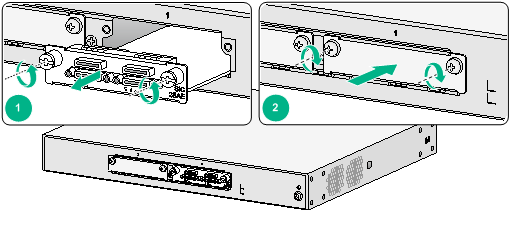
Replacing a transceiver module
To replace a transceiver module:
1. Remove the optical fibers from the transceiver module.
2. Release and pull down the bail latch on the transceiver module.
3. Hold the bail latch to pull the transceiver module straight out.
Keep the removed transceiver module secure.
Figure 18 Removing a transceiver module

Troubleshooting
|
|
IMPORTANT: · The barcode on the router chassis contains product information that must be provided to local sales agent when you return a faulty router for repair. · Keep the tamper-proof seal on a mounting screw on the chassis cover intact, and if you want to open the chassis, contact H3C for permission. Otherwise, H3C shall not be liable for any consequence. |
Power supply failure
Symptom
The router cannot be powered on and the PWR LED on the front panel is off.
Solution
To resolve the issue:
1. Power off the router.
2. Verify that the router is connected to the power source correctly.
3. Verify that the power source is operating correctly.
4. Verify that the power cord is in good condition.
5. If the issue persists, contact H3C Support.
Fan tray failure
Symptom
After the router starts up, the configuration terminal displays the following information:
%Jun 22 16:11:37:485 2018 H3C DEV/4/FAN FAILED:
Fan 1 failed.
Solution
To resolve the issue:
1. Replace the fan tray if one of the following conditions exists:
¡ An object has entered the chassis and gets stuck in the fan tray.
¡ The fan tray stops rotating.
2. Power-cycle the router.
3. If the issue persists, contact H3C Support.
No display on the configuration terminal
Symptom
The configuration terminal does not have display when the router is powered on.
Solution
To resolve the issue:
1. Verify that the power system is operating correctly.
2. Verify that the console cable is connected correctly and the connected serial port is the same as the port configured on the terminal.
3. Verify that the terminal is configured correctly:
¡ Baud rate—9,600.
¡ Data bits—8.
¡ Parity—None.
¡ Stop bits—1.
¡ Flow control—None.
¡ Emulation—VT100.
4. Verify that the console cable is in good condition.
5. If the issue persists, contact H3C Support.
Garbled display on the configuration terminal
Symptom
The configuration terminal has garbled display when the router is powered on.
Solution
To resolve the issue:
1. Verify that the Data bits field is set to 8 for the terminal. If the Data bits field is set to 5 or 6, the terminal displays garbled characters.
2. If the issue persists, contact H3C Support.
No response from the serial console port
Symptom
The console port on the router is connected to a serial port on a configuration terminal. No boot information is displayed on the configuration terminal when the router starts up or restarts up.
Solution
To resolve the issue:
1. Verify that the serial console cable is in good condition.
2. Verify that the port settings are correct.
3. If the issue persists, contact H3C Support.
Interface module failure
Symptom
An interface module is installed in the router, but the LED for the interface module is not on after the router is powered on.
Solution
To resolve the issue:
1. Verify that the interface module has good contact with the backplane of the router.
2. Verify that the router supports the interface module.
3. Verify that a correct interface cable is used.
4. Verify that the interface cable is connected correctly.
5. If the issue persists, contact H3C Support.
Restoring the factory settings
Scenario 1
Symptom
You want to access the router that you are to replace with a new one, but you cannot remember the password.
Solution
If you are not to save the configuration, press the RESET button for over four seconds to restore the factory settings. Then you can use the initial username and password to access the router.
If you are to save the configuration and a console cable is available, you can access the router from the BootWare menu.
Scenario 2
Symptom
The router cannot connect to the network after configuration modifications. The configuration is very complicated and it is hard to locate the errors.
Solution
If you have not saved any configuration, you can reboot the router by pressing the RESET button for a short time or power off the router.
If you have saved the configuration, delete the configuration file at the CLI or press the RESET button to restore the factory settings.
Scenario 3
Symptom
The router crashes.
Solution
Press the RESET button for a short time to reboot the router.
Reset button usage guidelines
The RESET button is used to reboot the system or restore the factory settings.
· To reboot the router, press the RESET button for a short time.
· To reboot the router and restore the factory settings, press the RESET button for over four seconds.
Appendix A Chassis views and technical specifications
Chassis views
The following figures are for illustration only.
Figure 19 Front panel

|
(1) Power receptacle |
(2) Gigabit Ethernet copper port GE0 |
|
(3) Gigabit Ethernet copper ports GE1 to GE4 |
(4) Gigabit Ethernet fiber port SFP5 |
|
(5) Console port (CONSOLE) |
(6) Reset button (RESET) |
|
(7) USB port |
|
Figure 20 Rear panel

|
(1) SIC 2 |
(2) SIC 1 |
|
(3) Grounding terminal |
|
Technical specifications
Table 7 Technical specifications
|
Item |
MSR2600-6-X1-GL |
|
Console/AUX port |
N/A |
|
Console port |
1 |
|
USB port |
1 |
|
GE copper port |
5 |
|
GE fiber port |
1 |
|
Reset button |
1 |
|
Memory |
1GB DDR3 |
|
Flash |
256 MB |
|
SIC slots |
2 |
|
Dimensions (H × W × D) (excluding rubber feet and mounting brackets) |
44.2 × 360 × 300 mm (1.74 × 14.17 × 11.81 in) |
|
Rated AC voltage |
100 to 240 VAC @ 50/60 Hz |
|
Max power consumption |
30 W |
|
Operating temperature |
0°C to 45°C (32°F to 113°F) |
|
Storage temperature |
–40°C to +70°C (–40°F to +158°F) |
|
Humidity |
5% RH to 95% RH, non-condensing |
Appendix B LEDs
Figure 21 LEDs

|
(1) System status LED (SYS) |
(2) Power status LED (PWR) |
|
(3) LEDs for Gigabit Ethernet copper ports GE0 to GE4 |
|
|
(4) LED for Gigabit Ethernet fiber port SFP5 |
|
|
LED |
Status |
Description |
|
System status LED (SYS) |
Slowly flashing green |
Comware has started with the configuration file and the router has booted up. |
|
Fast flashing green |
The system software image is being copied and decompressed. |
|
|
Steady green |
The SDRAM is performing self-test. |
|
|
Slowly flashing yellow |
The SDRAM has failed self-test. |
|
|
Fast flashing yellow |
The BootWare extended segment does not exist. |
|
|
Steady yellow |
The system software image does not exist. |
|
|
Off |
No power input, or exceptions have occurred. |
|
|
Power status LED (PWR) |
Steady green |
The power system is operating correctly. |
|
Off |
No power is being input. |
|
|
Gigabit Ethernet copper port LED |
Steady green |
A 1000 Mbps link is present. |
|
Flashing green |
Data is being received or transmitted at 1000 Mbps. |
|
|
Steady yellow |
A 10/100 Mbps link is present. |
|
|
Flashing yellow |
Data is being received or transmitted at 10/100 Mbps |
|
|
Off |
No link is present. |
|
|
LED for Gigabit Ethernet fiber port SFP5 |
Steady green |
A 1000 Mbps link is present. |
|
Flashing green |
Data is being received or transmitted at 1000 Mbps. |
|
|
Steady yellow |
A 10/100 Mbps link is present. |
|
|
Flashing yellow |
Data is being received or transmitted at 10/100 Mbps |
|
|
Off |
No link is present. |
Appendix C Slot arrangement
The router provides SIC slots. The fixed ports on the router panel are in slot 0.
Table 9 Slot arrangement
|
Router model |
Slot arrangement |
|
MSR2600-6-X1-GL |
|
|
|
|
Cleanliness,2
Connecting interface cables,14
Connecting the AC power cord,16
Connecting the console cable and setting terminal parameters,15
Cooling system,2
Electricity safety,1
EMI prevention,3
ESD prevention,3
General safety recommendations,1
Grounding the router,12
Installing a SIC,13
Lightning protection,4
Mounting the router in a rack,10
Mounting the router on a workbench,8
Rack requirements,4
Reset button usage guidelines,23
Safety symbols,1
Scenario 1,22
Scenario 2,22
Scenario 3,23
Solution,20
Solution,21
Solution,20
Solution,21
Solution,22
Solution,21
Symptom,20
Symptom,20
Symptom,21
Symptom,21
Symptom,22
Symptom,21
Temperature and humidity,1
Verifying the installation,17


